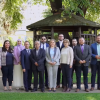Symptoms go away, life returns to normal, with the person back with family and friends. Narratives end with the take-home message: “I’m just like you!” Despite the infection and illness, the person is fundamentally human and worth the kind of inherent dignity due to all people.
A couple of days ago, my mother and I encountered a woman walking heavily past our front yard, the sun was draining her energy so we offered her a bottle of water. She looked at us while keeping her distance and the first thing she said was: “Do you have any ill people in your house?”, confused we asked her what she meant, then she elaborated: “I haven’t talked to anyone since the pandemic outbreak, you never know who’s infected or not. Even when they say they are healed; I don’t believe them.” My mother and I informed her that, we haven’t had any health issues, to which she said she’s happy to hear that and slowly walked away.
The encounter inspired me to dig deeper into the disinformation on social media that gave birth to a new illness – the stigma of covid – 19.
The first case that I came upon, was the one on 21 March, about a four-year-old child who returned from England to Stip, she showed symptoms of the virus and was declared positive after the coronavirus test. The girl’s father, talked to the Macedonian Information Agency MIA, where he denied the speculations published about the girl on social media and in the news and asked for an end to the hate speech and misinformation about this case. “My child did not come from England with symptoms, as the media claims or as I see comments on social media. We are British citizens and have health insurance in England. I am outraged that there are all sorts of misinformation about our case. I responsibly claim that we received an e-mail from the kindergarten in England on Tuesday, informing us to test ourselves because they have a case of a sick parent of a child in the kindergarten where my daughter was taken care of “, said the concerned father to MIA.
Another case that caught my attention was coming from a Doctor also from Stip who said that he cannot remain indifferent while lies are spreading about him in public. In his Facebook address, he happily announced that his wife and daughter were negative after the coronavirus test, but that, unfortunately, their phone calls would not stop ringing and comments on social media were not easy to endure: “I feel a responsibility to share with you all the details, so that the lies that poison us every day and aim to discredit us both as professionals and as people finally stop!”
The truth is that we are in unchartered territory here. Confusion worsens when some people publicly and loudly question whether this is a true threat or a hoax perpetrated by some mal-intended segment of society. Confusion is the breeding ground of stereotypes, prejudice, and discrimination. Humans as psychological beings have a deep-seated need to understand the “why” of an event, especially unusual and threatening happenstance. Why is the coronavirus pandemic plaguing the globe? What is to blame?
Stigma arises when the virus and the person with the virus are conflated; when we change the question from what’s to blame to who’s to blame. Years of research by psychologists and scientists have shown that the stigma of mental and physical illnesses extended to people with these illnesses can be as harmful as the symptoms themselves.
Who is likely to be harmed by the stigma of the coronavirus? People testing positive for the virus or showing symptoms are the most obvious victims. Erving Goffman viewed these people as having spoiled or tainted identities which justifies prejudicial responses against them. Families and friends of identified patients may also be stigmatized by extension[1].The Institutions are calling for social distance as the primary tool for flattening the curve to decrease the rate of infection. It is preferred that people keep a physical separation by six feet apart as the minimum rule. The risk of stigma occurs when distance from the virus is confused with distance from the tainted individual.
So, what do we do about stigma during the pandemic? First and foremost is to call it out. People are being disrespected and discriminated against because of Covid-19 and it is wrong just like any forms of racism, sexism, and ageism.
This kind of stigma harms people with Covid-19 in three ways. First is public stigma, harm that results when people endorse stereotypes about individuals with Covid-19 (“they’re tainted”) leading to discrimination: not renting to people who may have been exposed, excluding them from school, or not inviting them into your faith-based community. Second is self-sigma: the disrespect that results when people associated with the virus internalize stereotypes and feel tainted or dirty. It is difficult enough dealing with the virus; in addition, people are supposed to be ashamed of themselves.
Third is what has been called label avoidance. Goffman said stigma is an obvious and observable mark, that the public discriminates against; for example, Black people because of skin color, women because of body type, and elder citizens because of gray hair. The mark of most stigmatized health conditions is different because it is hidden; one cannot tell, for example, who in a room of one hundred people is positive for the coronavirus. The stigma of health arises from a label. “Hey, that’s Mark and he has coronavirus.” And labels most typically occur because of testing and treatment experiences. “I just saw Mark drive away from the public coronavirus drive-up line in my town. He must be infected!” People will try to avoid the label by avoiding health-related experiences. Because of label avoidance, they will choose not to be tested or will not isolate should results be “positive.”
The myths of illness are diminished when people learn facts about transmission, prognosis, and treatment. Everyone can be part of this effort by absorbing information and sharing with one’s social network. This is best accomplished by linking with websites for each center/institute/agency which now have regular posts for public consumption about the pandemic as it plays out.
In addition, everyone promotes education by being alert for misinformation. For example, several media sites have passed on assertions about Covid-19 that are not supported by the research. This leads to a battle of opinions rather than an exchange of knowledge. Instead, everyone should share links with research evidence regarding the pandemic, encouraging readers to consider it for themselves.
According to Psy.D. Patrick Corrigan editor of Stigma and Health, a journal of the American Psychological Association, effective contact stories have two parts: on-the-way-down experiences and on-the-way-up results. On-the-way-down narratives discuss the process of being diagnosed and the fear it entailed, worries about infecting others, and challenges of symptoms. On-the-way-up results hail the reality of recovery; that symptoms go away, life returns to normal, with the person back with family and friends. Narratives end with the take-home message: “I’m just like you!” Despite the infection and illness, the person is fundamentally human and worth the kind of inherent dignity due to all people.
The anti-stigma campaign must continue after the pandemic ends. In fact, the lingering effects of attitudes about people who tested positive may be an enduring legacy of the worldwide infection. In an atmosphere of fear and confusion, stigma becomes a lasting stain on people associated with the illness.
Meral Musli Tajroska – Psychologist, Consultant on violent extremism and radicalization, activist for gender equality.
Source: Psychology Today
[1] https://www.psychologytoday.com/intl/blog/the-stigma-effect/202004/the-stigma-covid-19









